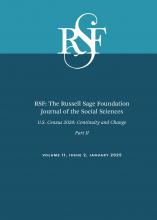Research Article
Open Access
Stalled Progress? Five Decades of Black-White and Rural-Urban Income Gaps
Bradley L. Hardy, Shria Holla, Elizabeth S. Krause, James P. Ziliak
RSF: The Russell Sage Foundation Journal of the Social Sciences January 2025, 11 (2) 115-136; DOI: https://doi.org/10.7758/RSF.2025.11.2.06
Bradley L. Hardy
aProfessor of public policy at Georgetown University, United States
Shria Holla
bEconomist at the Federal Reserve Bank of Chicago, United States
Elizabeth S. Krause
cDoctoral student in the economics department at the University of Kentucky, United States
James P. Ziliak
dProfessor and Carol Martin Gatton Endowed Chair in the economics department at the University of Kentucky, United States

REFERENCES
- ↵
- Abraham, Katherine, and
- Melissa Kearney
- ↵
- ↵
- Auerbach, Alan J., and
- Joel Slemrod
- ↵
- Austin, Benjamin,
- Edward Glaeser, and
- Lawrence Summers
- ↵
- Autor, David
- ↵
- Autor, David,
- David Dorn, and
- Gordon Hanson
- ↵
- Bayer, Patrick, and
- Kerwin Charles
- ↵
- Black, Dan, and
- Seth Sanders
- ↵
- Blank, Rebecca
- ↵
- Blundell, Richard,
- Robert Joyce,
- Agnes Norris Keiller, and
- James P. Ziliak
- ↵
- Bollinger, Christopher R.,
- Barry Hirsch,
- Charles Hokayem, and
- James P. Ziliak
- ↵
- Bollinger, Christopher,
- James P. Ziliak, and
- Kenneth R. Troske
- ↵
- Bonds, Michael
- ↵
- Bradshaw, Michael
- ↵
- Breathitt, Edward
- ↵
- Brown, Dorothy A
- ↵
- Case, Anne, and
- Angus Deaton
- ↵
- Caudill, Harry
- ↵
- Chandra, Amitabh
- ↵
- ↵
- Clark, Shelly,
- Sam Harper, and
- Bruce Weber
- ↵
- Cullen, Julie Berry, and
- Jonathan Gruber
- ↵
- Currie, J
- ↵
- Darity, William A., Jr.., and
- Samuel L. Myers Jr.
- ↵
- Darity, William A., Jr.., and
- Samuel L. Myers Jr.
- ↵
- Duncan, Cynthia
- ↵
- Economic Research Service
- ↵
- Eissa, Nada, and
- Hilary W. Hoynes
- ↵
- Eissa, Nada, and
- Jeffrey B. Liebman
- ↵
- Eller, Ronald
- ↵
- Fording, Richard C.,
- Joe Soss, and
- Sanford F. Schram
- ↵
- Gale, William G
- ↵
- Gooden, Susan T., and
- Samuel L. Myers Jr.
- ↵
- Grogger, Jeffrey, and
- Lynn A. Karoly
- ↵
- Hardy, Bradley L.,
- Charles Hokayem, and
- James P. Ziliak
- ↵
- Hardy, Bradley L.,
- Trevon D. Logan, and
- John Parman
- ↵
- Hardy, Bradley L.,
- Rhucha Samudra, and
- Jourdan A. Davis
- ↵
- ↵
- Harvey, Mark H., and
- Rosalind P. Harris
- ↵
- Heckman, James, and
- John J. Donohue
- ↵
- Holtzblatt, Janet,
- Swati Joshi,
- Nora Cahill, and
- William Gale
- ↵
- Hotz, V. Joseph, and
- John Karl Scholz
- ↵
- Hoynes, Hilary W., and
- Diane W. Schanzenbach
- ↵
- Islam, Tonmoy,
- Jenny Minier, and
- James P. Ziliak
- ↵
- ↵
- Kalil, Ariel,
- Kristin S. Seefeldt, and
- Hui-Chen Wang
- ↵
- Kline, Patrick, and
- Enrico Moretti
- ↵
- Lee, Jennifer, and
- Frank D. Bean
- ↵
- ↵
- Lichter, Daniel T., and
- Deborah R. Graefe
- ↵
- Lichter, Daniel T., and
- Kenneth M. Johnson
- ↵
- ↵
- Loury, Glenn
- ↵
- Lundberg, Shelly
- ↵
- Moffitt, Robert A
- ↵
- Moffitt, Robert A., and
- James P. Ziliak
- ↵
- Monnat, Shannon M
- ↵
- Moore, Richard A., Jr.
- ↵
- Moynihan, Daniel Patrick
- ↵
- Murray, Charles
- ↵
- Myrdal, Gunnar
- ↵
- National Bureau of Economic Research (NBER)
- ↵
- Neal, Derek, and
- William R. Johnson
- ↵
- Neal, Derek, and
- Armin Rick
- ↵
- Nichols, Austin, and
- Jesse Rothstein
- ↵
- ↵
- Parolin, Zachary
- ↵
- Parolin, Zachary,
- Matthew Desmond, and
- Christopher Wimer
- ↵
- Piketty, Thomas, and
- Emmanuel Saez
- ↵
- Rothstein, Richard
- ↵
- ↵
- Smith, James P., and
- Finis R. Welch
- ↵
- Snyder, Anastasia R., and
- Diane K. McLaughlin
- ↵
- Stephens, Melvin
- ↵
- Tickamyer, Ann R.,
- Jennifer Sherman, and
- Jennifer Warlick
- ↵
- U.S. Census Bureau
- ↵
- ↵
- Wilson, William J
- ↵
- Ziliak, James P
- ↵
- Ziliak, James P
In this issue
Stalled Progress? Five Decades of Black-White and Rural-Urban Income Gaps
Bradley L. Hardy, Shria Holla, Elizabeth S. Krause, James P. Ziliak
RSF: The Russell Sage Foundation Journal of the Social Sciences Jan 2025, 11 (2) 115-136; DOI: 10.7758/RSF.2025.11.2.06





